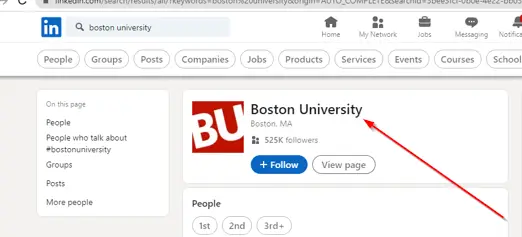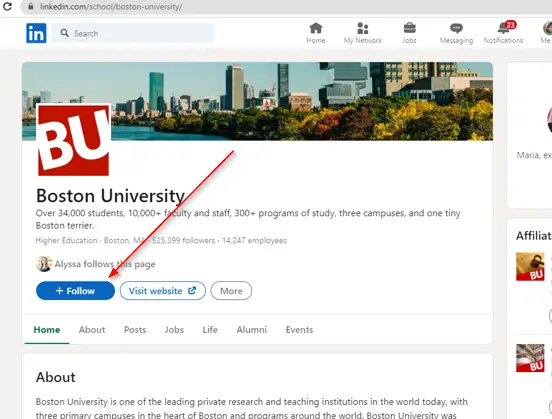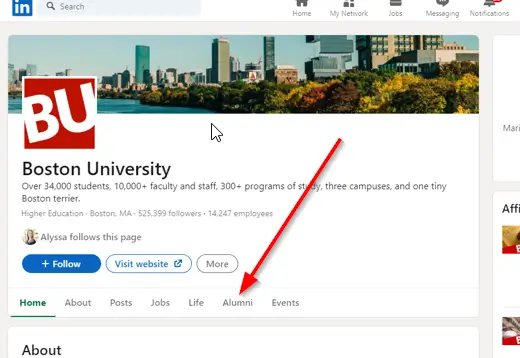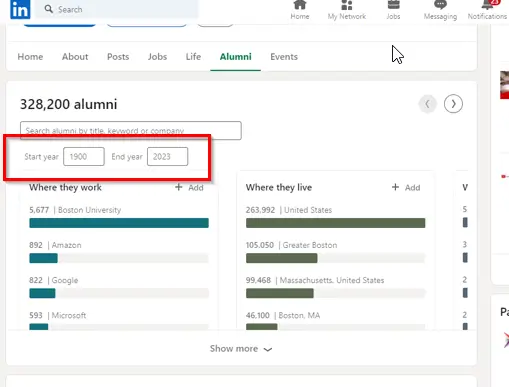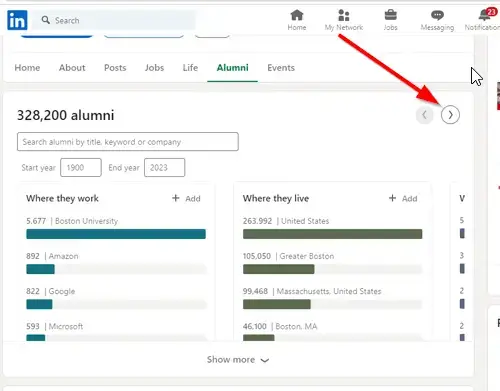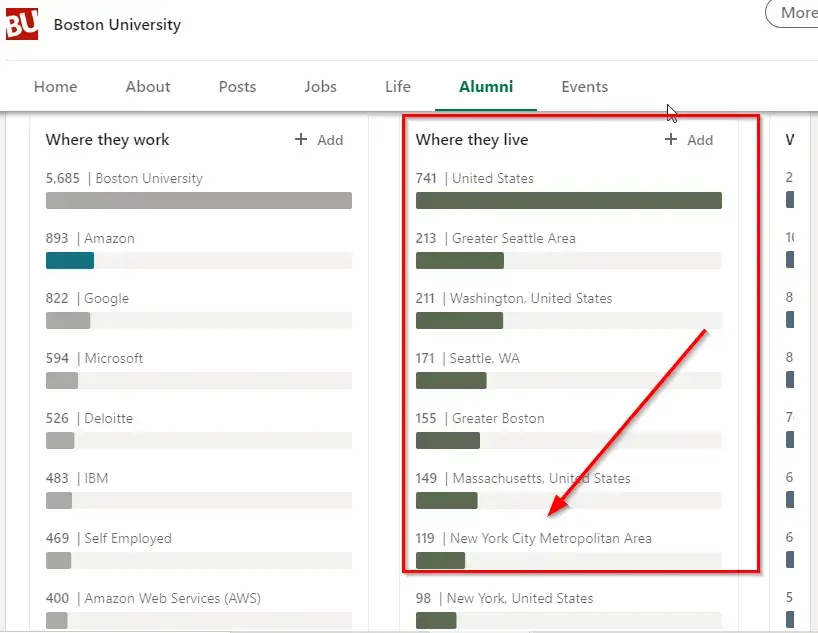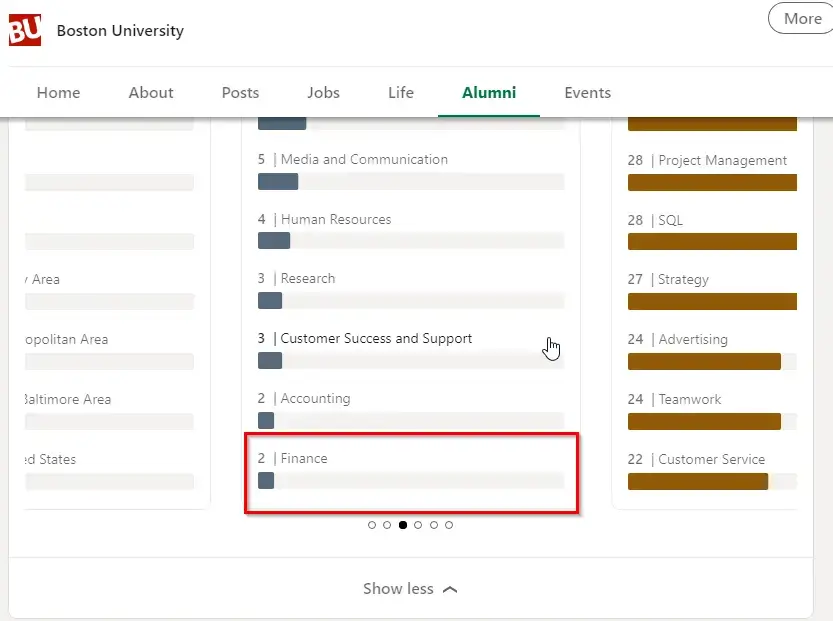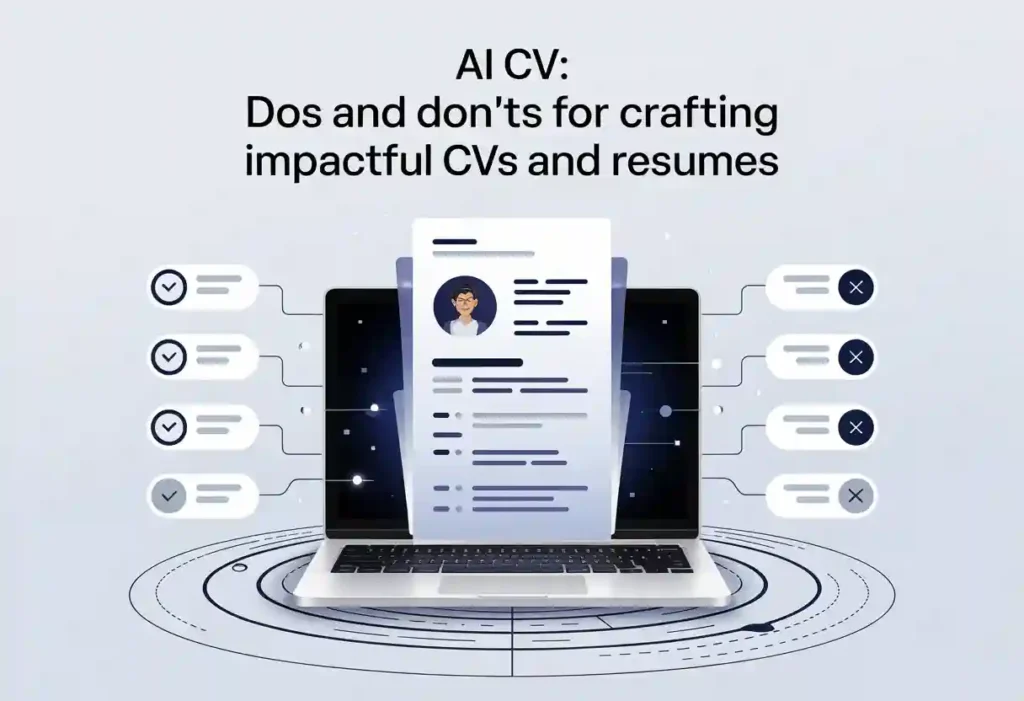From Grad to Great: Using Your Alma Mater For Career Success
Connecting with alumni has many benefits. However, providing practical examples and techniques for leveraging these connections for professional growth and career success can take time and effort.
This article will answer any questions you may have about LinkedIn alumni connections and will cover the following key areas:
- What university alumni networks are
- How to use the LinkedIn alumni tool
- A step-by-step guide to getting started on the LinkedIn alumni tool
- Personalized LinkedIn message examples
- Benefits of connecting with alumni (straight from your LinkedIn profile)
Imagine being a recent graduate, feeling lost among many job seekers. You send out resumes, but they disappear into a black hole.
Recruiters don’t even send you the depressing ‘Sorry, we cannot proceed with your application’ email. Days become weeks; weeks become months. And you begin to wonder what you did wrong.
But don’t worry anymore. There’s a secret weapon that can transform your job search journey. It’s time to put your school days to actual use and tap into the power of your old school’s friends.
Let’s travel back to my post-graduation days. Like you, I found myself scrolling through never-ending job boards. Hoping for a breakthrough.
But with every new search, it seemed that it would never come. Then, I discovered the magic of connecting with my fellow alumni on LinkedIn.
I want you to imagine this. You’re sitting in a cozy coffee shop. You’re savoring your latte when you converse with random strangers. To your surprise, one graduated from the same school as you.
He’s a fellow ABC University alum. Immediately, there’s a spark of familiarity, a shared understanding of the university experience.
You didn’t think it would be possible to find alumni in this new city that you were in. It’s like finding a long-lost sibling in the professional world.

This is the power of your network of alumni, and LinkedIn is here to help you harness it. In this article, we’ll guide you through the incredible world of LinkedIn’s alumni tool.
You’ll learn to connect with your fellow alumni and tap into their knowledge. You might even score job interviews through employee referrals.
LinkedIn’s alumni tool makes it easy to find and connect with alumni from your former university. Whether you’re a graduating senior looking for your first job or a professional looking to switch industries doesn’t matter.
The vast alumni network is at your fingertips, making it easier than ever to build relationships and expand your professional network.
So, dust off your resume, wear your networking cap, and join us on this exhilarating adventure. Together, we’ll navigate the world of LinkedIn. We’ll show you how to connect with alumni and unlock opportunities.
Get ready to take your job search to new heights with the power of your alumni community. Make your career dreams a reality.
Expert Advice
Kelly Cleary, the Dean of Career and Professional Advising at Haverford College, says networking is the number one way to gain career advice and find employment in today’s competitive job market.
Luckily, as students, we have a ready-made network at our fingertips. It’s our family, friends, and fellow university alumni.
When it comes to connecting with alumni, LinkedIn is the ultimate tool. You can easily find and connect with fellow university alumni in just a few minutes.
The vast network of alumni on LinkedIn provides a wealth of opportunities:
- To explore different career paths
- Expand your professional network
- And gain valuable insights into various industries
The beauty of connecting with your fellow alumni is that you already have a shared experience of studying together. This lays the foundation for a professional relationship built on trust, understanding, and camaraderie.
You can tap into the collective knowledge and experiences of those going through the same job-hunting process. And you only have to join the relevant alumni groups on LinkedIn.
On LinkedIn, you can:
- Search for specific job titles
- Explore different career paths
- Connect with graduates who are working in your desired fields
Send connection requests and build relationships. You can connect with other job seekers, people who attended school with you, and young professionals. This can open doors to potential job opportunities, mentorship, and valuable career advice.
LinkedIn’s features, such as the alumni tab and LinkedIn groups, allow you to:
- Easily access alumni profiles
- Stay updated on their career journeys
- And showcase your up-to-date profile and skills
Don’t underestimate the power of a well-curated LinkedIn presence. It can make all the difference in attracting the attention of potential employers. And connect you with helpful individuals in your industry.
Take advantage of this invaluable resource.
With LinkedIn, you can connect, learn, and grow as you navigate the job market and shape your career path.
CVJury offers expert advice on every step of the job search.
That is, from networking with college alumni (university alumni) to writing the best cover letter and CV or Resume.
Read our story to learn how we can help you find your dream role.

What Is A University Alumni Network?
This network consists of current and former students. Students who have attended the same educational institution.
It is a valuable platform for postgraduates to maintain connections with their classmates. And for undergraduates to seek guidance from senior peers.
Every university, college, and high school has one, formally established or informally maintained.
Connecting with those who graduate with you can be done through various avenues. Many educational institutions offer an online platform or forum designed for alumni. These platforms provide opportunities to:
- Discuss career prospects
- Exchange advice
- And tap into the collective knowledge of others
Universities may also organize social events that bring together alumni. These provide networking opportunities and a chance to build meaningful connections.
There are several approaches you can take to connect with your university alumni. Attending social events organized by your alma mater is a great way to meet fellow graduates. You’ll have the opportunity to see them face-to-face and establish personal connections.
Another option is reaching out to alumni through social media platforms. You can find and connect with them based on their alma mater or mutual interests.
LinkedIn offers a powerful tool for connecting with alumni. Through its alumni feature and search functions, connecting has never been easier.
LinkedIn’s alumni tool allows you to find and connect with fellow alumni from your university. You can send connection requests and explore their profiles. You can even learn more about their career paths.
By using this tool, you can
- Build a solid professional network
- Seek advice
- And discover new job opportunities within your alumni community
Connecting with your university alumni can open up a world of possibilities.
How To Use The LinkedIn Alumni Tool
Firstly, let’s open the LinkedIn alumni (university alumni) tool.
The very first step you take would be to search for your former university. Let’s say you went to Boston University. Go to your LinkedIn Home page and find the search bar.
Search for Boston University.
This will take you to the Boston University home page. Click that ‘Follow‘ button.
Now, we’ll start using the ‘Alumni‘ tool.
You’ll now be on the first page of Boston University’s alumni section. This is where it gets interesting.
LinkedIn has structured the page so you can view your alumni network from any school year to the current year.
You will also see the following search options:
- Where they work
- Where they live
- What they do
- What they are skilled at
- What they studied
- How are you connected
You can move the page to the next search function using the arrow keys.
Scrolling down the page will find possible connections that fit your search criteria (e.g., geographic region).
So, let’s refine our search. I’ll use a hypothetical scenario to show you exactly how valuable the LinkedIn tool is.
I’ve just received a job offer in the finance department at Amazon. The office is in New York. Before I make the decision, I need to know some of the following things:
- What is the work culture in the office?
- What is the area around the office like?
- Can I find affordable housing? If not, where would I be able to live?
- And what is the commute like?
- Does this person perhaps know your new manager? What are they like to work for?
Using the LinkedIn alumni tool, we’ll narrow the search down and use the search results to find the right person to connect with.
We will find all the alumni who work at Amazon using the handy search sections.
In the ‘Where do they work’ section, you find Amazon.
This will narrow the search to all 852 people working at Amazon. Remember, these are all fellow alumni of Boston University.
Next, we’ll look for all the alumni living in New York.
Again, the search results are narrowed, and we can see that it’s now reduced to 119 people.
The next step is finding the proper connection by the ‘what they do’ option.
Scroll down until you find the finance section.
Finally, you’ve narrowed your search down to two possible connections.
Now we’ll dive into getting connected. How to go about it and the common mistakes to avoid to ensure that the person accepts your request.
Top Tip
Don’t write generic blast messages. This is guaranteed to give you a low invitation acceptance rate.
If you want a response to your request, take some time to write a personalized LinkedIn request message.
Personalized LinkedIn Message Examples
Example One: 👋
Connection Request Message
Hi [Professional Name],
I hope you’re doing well.
Would you kindly accept my connection request so I can follow your activities and thoughts?
I noticed you graduated from [school name]; I’m also an alumnus.
I would be honored to connect to learn more about your post-[school name] experience.
Kind regards,
[Your Name]
What Not To Do When Sending a Connection Request:
- Don’t send generic connection requests. Get personal. Stand out from the crowd.
- Don’t put it on blast. Consider relevance.
- Don’t be random. Have a clear purpose or mutual benefit.
- Don’t be overly aggressive or pushy.
- Don’t forget to thank someone for accepting your connection request.
- Don’t be a stranger. Send requests to people you’ve had a prior interaction with.
- Don’t send connection requests solely based on someone’s job title or company.
- Don’t use defaults. Customize your requests.
- Don’t send connection requests without reviewing the recipient’s profile first.
- Don’t be an annoyance. Wait a while before sending a second request.
What do you do if a connection request is ignored or the alum is not responding? Here are a few helpful tips to help you get connected:
- Gentle reminders – Send a polite and friendly follow-up message.
- Be visible – Engage with their posts and content on LinkedIn.
- Be interesting – Share relevant and valuable resources with the alum.
- Re-introduce yourself – Explore mutual connections and ask for introductions to re-establish contact.
- Join the conversation – Interact indirectly in groups where they are active.
- Attend events or webinars where they are speaking or participating.
- Consider reaching out through alternative channels, like email, if available.
- Respect their decision if they choose not to respond and move on gracefully.
- Focus on building relationships with other responsive alumni connections.
- Occasionally revisit unresponsive connections to reconnect in the future.
TOP TIP
Once the alumnus has accepted your message request, follow up with a second message.
This kind of communication will help to build rapport.
After A Fellow Alumni Has Accepted Your Request
Hi [Professional Name],
Thank you for connecting with me.
I want to keep in touch in the coming weeks if you are willing.
Many thanks,
[Your Name]
Based on their response, you can then ask about more personal and professional life, for example:
Building Rapport
Hi [Professional Name],
I would like to know more about you and what you do professionally when you have some spare time.
I’m always curious to learn what my fellow university alumni (e.g., Boston University alumni) went on to do after graduating.
Many thanks,
[Your Name]
Example Two: 👋
Request Information From Your Alumni
Hi [Professional Name],
I found your profile on LinkedIn and saw that we are alumni of [school name].
I also noticed that you are currently working for [company name].
Would you like to share your thoughts on working at [company name]?
I’m sure your experience has given you great insights into the industry.
I want to discuss it with you when you have spare time.
Would you be available for a brief call sometime next week?
My schedule is flexible, so please advise me on which day and time works best for you.
Kind regards,
[Your Name]
After this first connection, you would then be able to move things forward.
For example, either with further conversations like the ones above or something else.
I’ve been rejected, now what do I do?
- Don’t take rejection personally; it’s a natural part of networking.
- Reflect on your connection request to identify areas for improvement.
- Focus on quality over quantity when sending connection requests.
- To stay connected, engage with their content by liking, commenting, or sharing.
- Seek other ways to build rapport, such as attending the same events or joining similar groups.
- Learn from the rejection and adjust your approach for future connection requests.
- Maintain a positive attitude, and don’t let rejection discourage your networking efforts.
- Keep exploring new connections and opportunities beyond the rejected request.
- Remember that rejection does not define your worth or potential for success.
- Build a strong network with those who value and appreciate your connections.
Like this post?
Sign up for our blog updates and never miss a post.
We’ll send you A FREE job interview eBook as a thank-you.
Benefits of Connecting With Alumni (Straight From Your LinkedIn Profile)
Connecting with alumni on LinkedIn can bring a plethora of benefits. Open yourself up to opportunities for professional growth. These are some of the advantages of using the LinkedIn alumni tool:
- The LinkedIn Alumni Tool provides massive opportunities to find and connect with alumni from your school. You can unearth a network of potential mentors, collaborators, and industry professionals.
- Group gathering
Join alumni groups on LinkedIn to engage with like-minded individuals. Find people with a common educational background [or even a non-traditional background from yours. These groups can offer a vibrant community for networking, knowledge sharing between group members, and career development.

Make the most of LinkedIn Alumni Groups:
- Identify and join relevant LinkedIn groups related to your alma mater or industry.
- Actively participate in these group discussions – share insights and add value.
- Connect with alumni who have similar professional interests or backgrounds.
- Use the tools at your disposal – the search feature within groups can help you find specific alumni profiles.
- Network effectively – attend virtual events or webinars organized by alumni groups.
- Connect, connect, connect. Engage in one-on-one conversations with alumni through private messages.
- Prove your worth. Share relevant articles or resources to establish yourself as a valuable connection.
- Be helpful – Offer assistance or advice to fellow group members to build rapport.
- Find your mentor – Seek mentorship opportunities within the alumni community.
- Stay consistent. Foster long-lasting connections with active engagement.
- Job Title Alignment
Connect with alumni who hold job titles that align with your career aspirations. This opens doors to:
- Valuable insights
- Advice
- And potential job opportunities in your field
- Alumni Group Management
Take an active role in managing or co-managing an alumni group. Becoming a group manager allows you to establish yourself as a leader within the community. It can also allow you to expand your network and showcase your expertise.
- LinkedIn Group
Engage with LinkedIn groups that are relevant to your industry or interests. Take part in discussions and share valuable insights. You can establish yourself as a thought leader among your fellow alumni.
- Social Media Marketing
Leverage LinkedIn as a platform for personal branding and social media marketing. Connect with alumni who excel in the field. Learn from their strategies and experiences.
- Work of Fellow Alumni
Explore the profiles of alumni who have succeeded in their respective fields. Monitor where your fellow alumni work and earn from their career paths, achievements, and lessons learned.
- Expand Beyond One
Don’t limit yourself to connecting with alumni from just one university. Use the LinkedIn Alumni Tool to find and connect with alumni from many educational institutions. If you can find alumni from multiple universities, you can expand your network and diversify your connections.
- School Page Secrets
Use your school’s LinkedIn page to discover alumni success stories, job postings, and relevant LinkedIn updates. Stay informed about events, reunions, and networking opportunities organized by your old school.
- Helpful Hubs
Engage with helpful individuals who are active on LinkedIn. A helpful person may be able and willing to provide guidance and support. Reach out to them for:
- Mentorship
- Career advice
- Or to seek their opinions on your professional endeavors

TOP TIP (How to expand your Job Market):
- Use the search filters. Find alumni in specific industries or companies.
- Engage in meaningful conversations. Comment on alumni’s posts or articles.
- Attend alumni networking events or virtual meetups to expand your connections.
- Seek informational interviews with alumni. Gain insights from other professionals in your field.
- Don’t hesitate to ask for referrals or recommendations from well-connected alumni.
- Offer your skills or expertise to alumni in need. This creates mutually beneficial relationships.
- Join alumni associations or professional groups to access job boards and exclusive opportunities.
- Use LinkedIn alumni tools to explore career paths and companies employed by alumni.
- Leverage alumni networks for internships, freelance projects, or part-time opportunities.
- Stay active! Share industry-related content to enhance your professional visibility.
Remember, when connecting with alumni on LinkedIn, ensure your profile represents your best self:
- Use a captivating profile photo
- Optimize your headline
- Showcase your achievements and skills effectively
Don’t be afraid to step out of your comfort zone. Connect with alumni with diverse backgrounds who don’t share your geographic location or first-degree connection.
Embrace the fall season of networking,

Further Reading
50 expert LinkedIn influencers to follow, no matter your industry.
Linked with Legacy: Leveraging LinkedIn for Alumni Success
You have now discovered the immense value of your school’s alumni database. And how platforms like the LinkedIn alumni tool can be powerful tools for connecting with graduates from the same university.
In today’s interconnected world, your network truly has the potential to determine your net worth. So, take advantage of your alumni group.
Now is the time to act and make the most of these connections. As a recent graduate embarking on your job search, using the alumni tool should be a priority. LinkedIn can expand your business whether you’re a graphic designer or public relations practitioner, make YouTube videos for a living, or do any other job function.
Don’t underestimate the power of these relationships; they can:
- Open doors to countless career opportunities
- Provide valuable advice
- And even lead to lifelong friendships
Remember, building and nurturing connections takes effort. This is true whether you leverage your LinkedIn skills and use the LinkedIn alumni page, social media platforms, or other networking avenues.
Be proactive, reach out, and engage with your alumni on LinkedIn. Always personalize your messages. Showcase genuine interest in their experiences, and be open to learning from their journeys.
It is worth noting that networking can be exciting. Embrace it with enthusiasm and confidence. Take the first step.
Join a LinkedIn group, send a networking request to individual group members, attend social events, connect online, and explore the vast potential of finding other alumni on LinkedIn.
Remember, success rarely happens in isolation. Surround yourself with a diverse and supportive community. They can inspire, guide, and uplift you on your professional journey.
So, put yourself out there, make those connections, and watch as your network becomes an invaluable asset in shaping your future.


